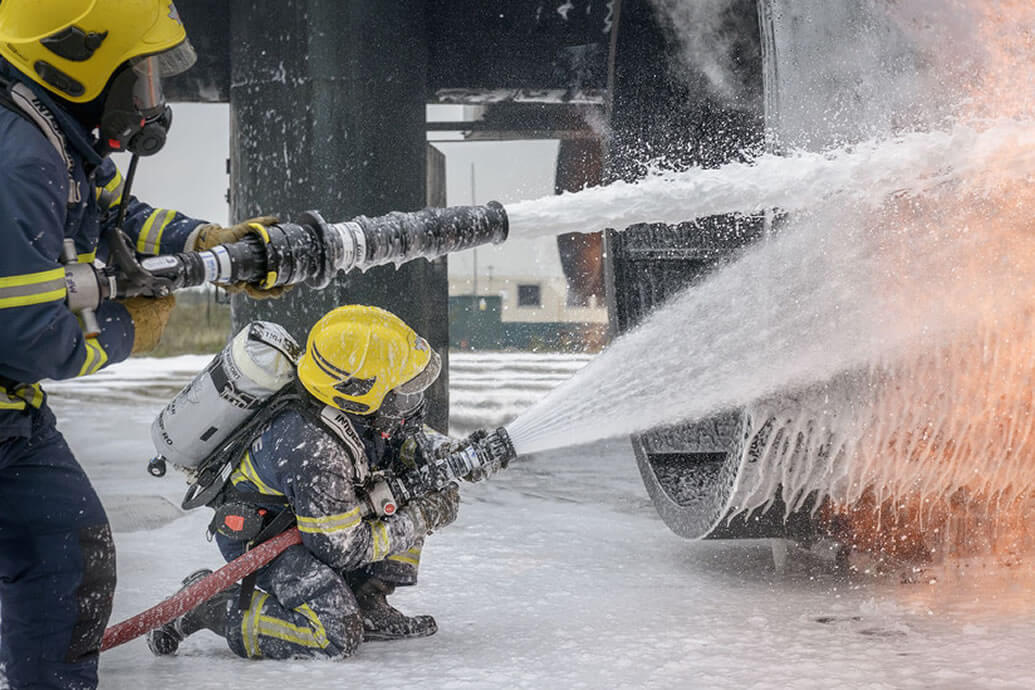Aircraft are a very visible high value asset, and few would argue against protecting them from fire during maintenance and storage in hangars. Whilst the fuel load will be reduced during storage, the residual fuel is still of concern. As with other active fire suppression systems the seat of the fire can never be predicted, so a ‘mix and match’ methodology is the approach in the design standards. However, whichever method is chosen, foam, explains Frank Preiss, Managing Director, FireDos Gmbh and his colleague, David Owen, will be at the heart of the solution.
Hangars by definition are large, enclosed spaces and plane shapes provide challenges that require careful design in the event of fire. Therefore, the two main design standards, NFPA 409 and EN 13565-2, require an assessment of both hangar door size and plane type before recommending the approach to be taken. Military standards can be somewhat similar, but this will be clarified by the country having most influence.
Hangars are classified by type, that is type 1, 2,3, 4 and the additional category of hangars specifically for livery painting. If we take type 1 hangars as an example, according to EN 13565-2, they have surface areas over 3700 m2 and gates with a width exceeding 8.5 m. They can house aircraft exceeding a 279m2 wing area. Under EN 13565-2 one of the following approaches should be taken for extinguishing:
Aspirated foam water deluge system with low level aspirated or non-aspirated monitors:
- High and low level Oscillating Foam/Water monitors
- High and low level Remote Control Foam/Water monitors
- High level High Expansion foam systems
- Detection will be part of the package and should include 2 forms of flame detection based on the performance objectives and application scenarios.
As high expansion foam is probably the medium least familiar to engineers and contractors of general foam extinguishing systems, it may be helpful to understand the key difference between it and the way unaspirated, low and medium expansion systems are calibrated.
Unlike those systems, high expansion foam is designed on a volumetric basis, that is the extent to which and how quickly the finished foam will cover a given depth in the hangar, rather than an application rate per square metre as in low and medium expansion foams. The foam generators are large devices mounted at roof height and driven by the incoming foam solution.
Typically, the combination of foam type, foam solution driven fan and fine steel mesh will produce an expansion ratio of more than 200:1. Extinction is a factor of the oxygen depleting and cooling qualities of the finished foam. Foam coverage of the entire aircraft storage and servicing area must be provided to within 1.5m of the doors and the perimeter walls within 3 minutes of system activation, to ensure any spreading of fuel is adequately covered. In addition, the foam build up must be at least 1m over the area to be protected within the first 60 seconds and exceed a minimum of 1.65 m/min up to the point, when the complete hangar is filled. This must also take into account a compensation factor for the breakdown of foam caused by sprinkler activation.
Large aircraft wings clearly provide a challenge to roof discharge systems but high expansion foam is very free flowing as long as even spacing of the generators is followed. However, supplementary underwing protection is required where wings exceed 280m2. The addition of underwing low level oscillating and remote-control foam monitors are the most effective means of ensuring full coverage. Self-oscillating monitors may well be preferred over full remote-control simply because of personnel evacuation policies. Nevertheless, remote camera monitoring can make remote control monitor installation an effective option.
Remote camera monitoring systems using infrared detection allow early identification of potential fire sources with rapid response times. Hazardous hotspots that may turn into a fire are identified quickly, even before smoke or flames appear. The early fire detection system allows the full-surface monitoring of large areas using panoramic thermal imaging. Combined with intelligent analysing software, this enables the precise localisation of a fire source. In addition, remote-controlled monitors, such as the innovative, flow-optimised ‘Oval Flat Design’ manufactured by FireDos, are used for pinpointed extinguishing with water or foam. This helps avoid lengthy and costly system downtime and collateral damage with little effort. Under the wing extinguishing, using the FireDos horizontal flat jet nozzle, allows precise placement of water or foam.
All of the suppression options include equipment for the introduction of foam. This will require a central foam proportioning system with i.e. FireDos fire water driven foam proportioners as a preferred method.
The location of underwing foam monitor protection will be partly driven by the performance of the monitors themselves. A long throw and consistent spray pattern enhance the ability of the overall system to meet coverage requirements. Monitors which utilise a flow-optimised “oval flat” design means that a homogenous flow pattern, with minimised turbulence and reduced pressure loss, provides maximum range and consistency. Maintaining clear space is always an issue in hangars so monitors with a super compact footprint for underwing protection are ideal.
We can only give a brief overview as hangar protection is one of the more specialised areas in fire suppression. We strongly recommend contacting your local in-country distributors for a full review and guidance on the methodology.


